Released: November 20, 2002
If you would prefer to download this file in
pdf format, click here.
Please note: Blank pages in pdf
files are deliberately placed for ease of double-sided printing.
Index

Quarter
in Review
The second quarter of fiscal year 2002-03 saw great uncertainty regarding the future path of the world economy. World equity markets continued to experience significant declines in stock values during the quarter ended September 30, 2002. The Canadian stock market measured by the Toronto Stock Exchange, S&P/TSX, declined 13.1% this quarter and 20.6% over six months. US stocks measured by the Standard & Poor 500 declined 13.7% this quarter and 28.8% over six months. The information technology sector lead the decline in value of share prices on world stock markets, declining 36.5% over the quarter and 67.1% over six months. The current bear market is one of the worst on record. This is the longest bear market since 1929-1932 and the deepest since 1937-38.
The decline in the equity markets can be attributed to a number of factors including the slowing world economy, threat of war with Iraq, accounting irregularities, the unwinding of excess capacity in the technology sector, reductions in corporate earnings forecasts and a general loss of investor confidence. The equity sell-off was indiscriminate as all regions and sectors were affected.
Despite significant declines in world equity markets, the Heritage Fund fared better. The Fundís risk exposure to short term stock market volatility is reduced through asset class diversification. In addition to equity investments, the Fund maintains significant holdings in bonds, real estate, mortgages and, beginning in September, absolute return strategies. Short-term declines in the value of equity investments are partially offset by increases in bonds, real estate and mortgages. The Canadian bond market measured by the Scotia Capital Universe Bond Index performed well, returning 4.2% over the current quarter and 7.5% over six months. As a result, the Heritage Fund recorded a negative rate of return of 6.5% this quarter and a negative 11.0% over six months.
The investment strategy of the Heritage Fund is focused on maximizing long-term investment returns. Historically, equities have outperformed fixed income securities over the long term.
At September 30, 2002, the fair value of the Fund stood at $11.1 billion down 5.9% from $11.8 billion at June 30, 2002 and down 10.5% from $12.4 billion at March 31, 2002.


Investment
Valuation
Investments and investment income are recorded on the financial statements of the Heritage Fund at cost in accordance with government accounting policies. The fair value of the Fund and its investments are provided for information purposes. Management uses fair value to assess the investment performance of the fund against market-based benchmarks.
The Fundís policy is to write down the cost of those securities where the decline in value below cost is not considered temporary. On a quarterly basis, management reviews the Fund's investment portfolio to identify those securities where the fair value has declined significantly below cost. Last quarter, the Fund wrote down the cost of Canadian and US public equities by $98 million. During the quarter ended September 30, 2002, an estimated provision for writedowns totaling $342 million was recorded against the cost of Canadian, US and non-North American equities. As a result of significant volatility in world equity markets, the estimated provision for writedowns is subject to change on a quarterly basis with the final determination of writedowns to be completed at year-end.

Investment Income
The Fund recorded a net loss of $576 million this quarter and $660 million over the six months ended September 30, 2002. Realized capital losses from declining world stock markets, primarily in the information technology and telecommunication services sectors, contributed to the loss. Over six months, losses from equity investments totaling
$820 million were partially offset by income from bonds, notes and short term paper totaling $144 million and real estate income of $16 million.


Forecasted Income
As a result of declining equity markets, a net loss of $627 million is forecast for the fiscal year ending March 31, 2003. On a consolidated basis, the forecasted net loss is $643 million. The consolidated forecasted loss excludes income from holdings of Alberta government securities and Provincial Corporation debentures.


Change in Net
Assets
The Heritage Fund accounts for its investments on a cost basis of accounting. Investment income on a cost basis excludes unrealized gains and losses. Investment income on a fair value basis includes unrealized gains and losses. The investment loss on a fair value basis was $760 million for the current quarter and $1,342 million over six months.


Transfers to
General Revenue Fund
The realized investment income earned by the Fund is not reinvested in the Fund. Instead, all of the net income is transferred to the Province's main operating fund, the General Revenue Fund (GRF), and used for Albertans' priorities like health care, education, roads, tax reductions and debt repayment. Changes in unrealized gains and losses are not included in amounts transferred to the General Revenue Fund. As a result of the Fund's net loss of $660 million over the past six months, no transfers are payable to the General Revenue Fund. The net loss of $660 million reduces the equity of the Heritage Fund. At September 30, 2002, the Fund's receivable from the General Revenue Fund of $180 million represents a recovery of transfers made to GRF during the past six months based on the original budget estimate of income for the fiscal year.

Investment Mix
The investment strategy is to invest in a diversified portfolio to optimize long-term returns at an acceptable level of risk. The policy asset allocation is reported in the Fund's 2002-05 business plan as follows:
For the 2002-03 fiscal year, the policy asset mix for fixed income securities remains the same as the previous year at 35%. The policy mix for public equity investments decreases from 58% to 50% while real estate investments are expected to increase from 7% to 10%, private equities and absolute return strategies increase to 2.0% and 3.0% respectively.
The actual investment mix changed over the past six months. Fixed income securities were reduced from 43.0% to 37.3%. Public equity investments remained about the same, decreasing slightly from 51.7% to 51.6%. Real estate investments increased from 4.7% to 7.7% of the Fund's total investment portfolio. A new investment asset class called Absolute Return Strategies was initiated late in the quarter and comprises 2.5% of the Fundís investment portfolio. Private equity investments increased from 0.6% to 0.9%.


Heritage Fund
Rate of Return
With declining long-term interest rates, it was decided to invest in assets that would provide higher long-term rates of return. This would mean a portfolio with a significant commitment to equities and real estate. Equity investments have a greater potential for variations in performance from year to year.
The Heritage Fund posted a negative rate of return of 6.5% this quarter and negative 11.0% over six months. Negative returns from Canadian, US, and non-North American public equity investments were partially offset by positive returns from the fixed income investments, real estate and private equities.
The performance of the Heritage Fund is measured over the long term. Over the past four-year period, the fund generated an annualized return of 1.5%.

The performance of the Heritage Fund investments is measured against various market-based indices. Value added by investment management is accomplished through asset mix decisions and security selection. The following sections describe the performance of the Fundís major asset classes in relation to their benchmark.

Fixed Income Investments
The Canadian bond market performed well this quarter. The Scotia Capital (SC) Universe Bond Index measures the performance of marketable Canadian bonds with terms to maturity of more than one year. Over the past quarter, the SC Universe Bond Index increased by 4.2% while the short term SC 91-Day T-Bill Index increased by 0.8%.


The Fundís actual rate of return over the quarter from long-term Canadian bonds was 4.2%, the same as the benchmark SC Universe Bond Index. The Fund's actual return from short-term securities was 0.8%, the same as the benchmark SC 91-Day T-Bill Index. Over four-years, the returns from long-term and short-term securities exceeded their benchmarks by 50 basis points and 20 basis points respectively. The out-performance over four years was due to higher weight in corporate bonds and duration management.
At September 30, 2002, investments in fixed income securities totaled $4.1 billion or 37.3% down from $5.4 billion or 43.0% at March 31, 2002.

Canadian Public
Equities
Declining corporate earnings forecasts contributed to the fall in the Canadian stock market over the quarter. The information technology sector led the decline. The Toronto Stock Exchange (S&P/TSX), which measures the performance of Canada's largest companies in ten industrial sectors, decreased by 13.1% over the quarter ending September 30, 2002.


The Heritage Fund's Canadian public equity portfolio is held in various investment pools, which are managed by internal and external managers. Over the quarter, the Fund's loss from Canadian equities was 12.8%, 30 basis points better than the benchmark S&P/TSX. Over four years, the Fund's return from Canadian equities was 2.8%, 120 basis points less than the benchmark.
At September 30, 2002, Canadian public equity investments totaled $2.2 billion or 20.2% of the Heritage Fund investment portfolio compared to $2.5 billion or 20.1% at March 31, 2002.

US Public
Equities
The US equity market declined over the quarter. The Standard & Poor 500 Index, S&P 500, which measures the performance of the top 500 American companies, decreased by 13.7% over the quarter in Canadian dollars.

The Fund's loss over the quarter from US public equities was 14.0%, 30 basis points less than the S&P 500. Over four years, the Fund's return from US equities was negative 2.8%, 40 basis points better than the benchmark.
At September 30, 2002, US public equity investments totaled $1.8 billion or 16.3% of the Heritage Fund investment portfolio compared to $2.0 billion or 15.8% at March 31, 2002.

Non-North
American Public Equities
Various external managers, who have expertise in foreign equity markets, manage the Heritage Fund's non-North American equity portfolio. The Morgan Stanley Composite Index for Europe, Australasia and the Far East, MSCI EAFE, measures the performance of approximately 1000 companies on 21 stock exchanges around the world. The index recorded a loss of 16.3% this quarter.
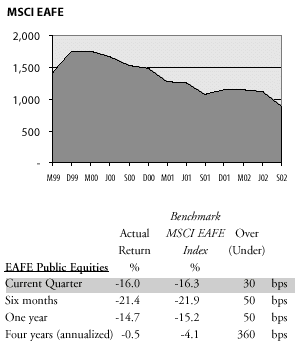
The Fund's actual loss from non-North American equities was 16.0%, 30 basis points better than the MSCI EAFE Index. Over four years, the Fund returned negative 0.5% from non-North American equities, 360 basis points better than the benchmark.
At September 30, 2002, investments in non-North American public equities totaled $1.6 billion or 15.1% of the Heritage Fund investment portfolio compared to $2.0 billion or 15.8% at March 31, 2002.

Real Estate Investments
The real estate market in Canada continued to grow this quarter. The Fund's real estate investments are held in the internally managed Private Real Estate Pool. Nearly half of the real estate portfolio is invested in retail, half in office and a small portion in industrial and residential. Approximately two-thirds of the real estate portfolio is invested in Ontario, one quarter in Alberta and a small portion in British Columbia and Quebec.
The Fund's real estate portfolio earned 0.8% this quarter, 140 basis points less than the benchmark, CPI plus 5%. Over 4 years the real estate portfolio returned 9.1%.
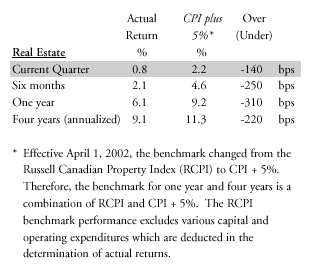
At September 30, 2002, investments in real estate totaled $839 million or 7.7%, up from $594 million or 4.7% at March 31, 2002.

Administrative
Expenses
Administrative expense includes investment management, cash management, custodial fees and other expenses. External management and custodial fees are deducted directly from the income of the externally managed investment pools. Internal administrative expenses are deducted from the internally managed pooled funds and directly from the Heritage Fund.
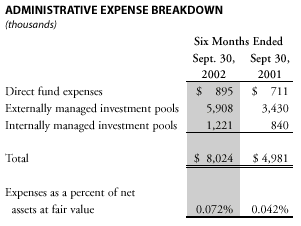
The increase in administrative expense is related to an increase in US and non-North American equity investments which are externally managed and more expensive to administer.
LOANS
Accrued interest receivable includes an amount due from Ridley Grain totaling $959,788. The amount relates to available cash flow distributable to the Fund. The interest shortfall totaling $16,140,239 has been added to the deferred interest balance (see Note 3(f)).

Business Plan
Performance Measures

The combined rate of return is determined by adding the proportionate market value returns of each portfolio and adjusting for the timing of cash flows from the Transition Portfolio to the Endowment Portfolio.


Alberta
Heritage Savings Trust Fund
Financial Statements
September 30, 2002 (unaudited)
Balance
Sheet
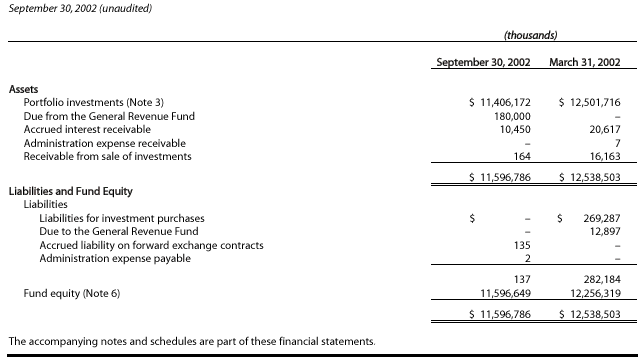
Statement of
Operations
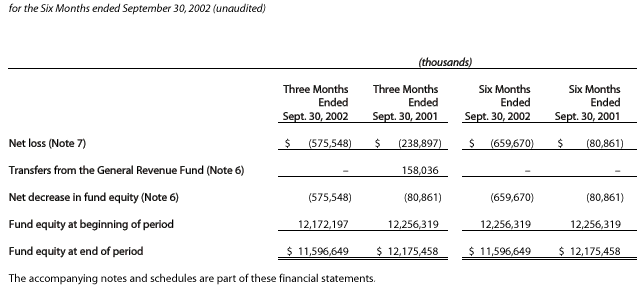
Statement of
Changes in Financial Position


Notes
to the Financial Statements
September 30, 2002 (unaudited)
NOTE 1 AUTHORITY AND MISSION
The Alberta Heritage Savings Trust Fund operates under the authority of the Alberta Heritage Savings Trust Fund Act (the Act), Chapter A-23, Revised Statutes of Alberta 2000, as amended.
The preamble to the Act describes the mission of the Fund as follows:
ďTo provide prudent stewardship of the savings from Alberta's non-renewable resources by providing the greatest financial returns on those savings for current and future generations of Albertans.Ē
NOTE 2 SUMMARY OF SIGNIFICANT
ACCOUNTING POLICIES AND REPORTING PRACTICES
These financial statements are prepared in accordance with generally accepted accounting principles.
The accounting policies of significance to the Fund are as follows:
(a) Portfolio Investments
Fixed-income securities, mortgages, equities, and real estate investments held directly by the Fund or by pooled investment funds are recorded at cost. Cost includes the amount of applicable amortization of discount or premium using the straight-line method over the life of the investments.
Investments in loans are recorded at cost less any allowance for credit loss. Where there is no longer reasonable assurance of timely collection of the full amount of principal and interest of a loan, a specific provision for credit loss is made and the carrying amount of the loan is reduced to its estimated realizable amount.
Investments are recorded as of the trade date.
The cost of disposals is determined on the average cost basis.
Where there has been a loss in value of an investment in fixed-income securities, mortgages, equities and real estate that is other than a temporary decline, the investment is written down to recognize the loss. The written down value is deemed to be the new cost. The estimated provision for writedowns, determined on an interim basis, is subject to change with the final determination of writedowns to be completed at year end.
(b) Investment Income
Investment income is recorded on the accrual basis where there is reasonable assurance as to its measurement and collectability. When a loan becomes impaired, recognition of interest income in accordance with the terms of the original loan agreement ceases. Any subsequent payments received on an impaired loan are applied to reduce the loan's book value.
Gains and losses arising as a result of disposals of investments are included in the determination of investment income. Income and expense from derivative contracts are included in investment income.
(c) Foreign Currency
Foreign currency transactions are translated into Canadian dollars using average rates of exchange, except for hedged foreign currency transactions which are translated at rates of exchange established by the terms of the forward exchange contracts. Exchange differences on unhedged transactions are included in the determination of investment income.
(d) Investment Valuation
Fair value is the amount of consideration agreed upon in an arm's length transaction between knowledgeable, willing parties who are under no compulsion to act. Fair values of investments held either directly by the Fund or by pooled investment funds are determined as follows:
(i) Public fixed-income securities and equities are valued at the period-end closing sale price, or the average of the latest bid and ask prices quoted by an independent securities valuation company.
(ii) Mortgages, provincial corporation debentures and private fixed-income securities are valued based on the net present value of future cash flows. These cash flows are discounted using appropriate interest rate premiums over similar Government of Canada benchmark bonds trading in the market.
(iii) The fair value of private equities is estimated by management.
(iv) Real estate investments are reported at their most recent appraised value, net of any liabilities against the real property. Real estate properties are appraised annually by qualified external real estate appraisers.
(v) The fair value of Absolute Return Strategy Pool investments is estimated by external managers.
(vi) The fair value of loans is estimated by management based on the present value of discounted cash flows.
(vii) The fair value of deposits, receivables, accrued interest and payables are estimated to approximate their book values.
(viii) The fair value of investments and any other assets and liabilities denominated in a foreign currency are translated at the period-end exchange rate.
(e) Valuation of Derivative Contracts
Derivative contracts include equity and bond index swaps, interest rate swaps, forward foreign exchange contracts and cross-currency interest rate swaps. As disclosed in Note 4, the value of derivative contracts is included in the fair value of pooled investment funds. The estimated amount receivable or payable from derivative contracts at the reporting date is determined by the following methods:
(i) Equity and bond index swaps are valued based on changes in the appropriate market based index net of accrued floating rate interest.
(ii) Interest rate swaps are valued based on discounted cash flows using current market yields.
(iii) Forward foreign exchange contracts are based on quoted market prices.
(iv) The value of cross-currency interest rate swaps is included with the value of the underlying security. Cross-currency fixed to fixed interest rate swaps are valued at quoted prices based on discounted cash flows using current market yields. Cross-currency fixed to floating interest rate swaps are valued at the principal amount plus accrued interest.
NOTE 3 PORTFOLIO INVESTMENTS

The majority of the Fund's investments are held in pooled investment funds established and administered by Alberta Revenue. Pooled investment funds have a market based unit value that is used to allocate income to participants and to value purchases and sales of pool units. As at September 30, 2002, the Fund's percentage ownership, at market, in pooled investment funds is as follows:
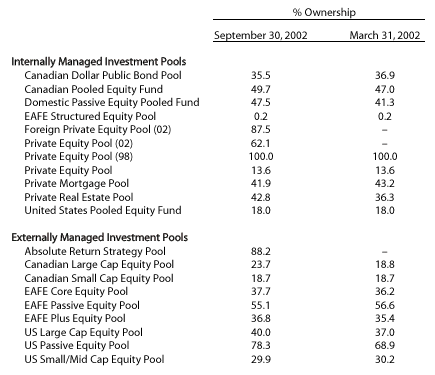
(a) The Consolidated Cash Investment Trust Fund is managed with the objective of providing competitive interest income to depositors while maintaining appropriate security and liquidity of depositors' capital. The portfolio is comprised of high-quality short-term and mid-term fixed-income securities with a maximum term-to-maturity of five years. As at September 30, 2002, securities held by the Fund have an average effective market yield of 2.93% per annum (March 31, 2002: 2.57% per annum).
(b) The Canadian Dollar Public Bond Pool is managed with the objective of providing above average returns compared to the total return of the Scotia Capital Universe Bond Index over a four-year period while maintaining adequate security and liquidity of participants' capital. The excess return is achieved through management of portfolio duration and sector rotation. The portfolio is comprised of high quality Canadian fixed-income instruments and debt related derivatives. As at September 30, 2002, securities held by the Pool have an average effective market yield of 5.10% per annum (March 31, 2002: 5.80% per annum) and the following term structure based on principal amount: under 1 year: 2%; 1 to 5 years: 36%; 5 to 10 years: 34%; 10 to 20 years: 10%; over 20 years: 18%.
(c) As at September 30, 2002, fixed-income securities held directly by the Fund have an average effective market yield of 3.84% per annum (March 31, 2002: 4.02% per annum) and the following term structure based on principal amount: under 1 year: 14%; 1 to 5 years: 86%.
(d) The Private Mortgage Pool is managed with the objective of providing investment returns higher than attainable from the Scotia Capital Universe Bond Index over a four-year period or longer. The portfolio is comprised primarily of high quality commercial mortgage loans (95.0%) and provincial bond residuals (5.0%). To limit investment risk, mortgage loans are restricted to first mortgage loans, diversified by property usage and geographic location, and include a small portion of NHA insured loans. As at September 30, 2002, securities held by the Pool have an average effective market yield of 6.32% per annum (March 31, 2002: 7.01% per annum) and the following term structure based on principal amount: under 1 year: 5%; 1 to 5 years: 31%; 5 to 10 years: 19%; 10 to 20 years: 26%; and over 20 years: 19%.
(e) As at September 30, 2002, Provincial corporation debentures held directly by the Fund have an average effective market yield of 8.37% per annum (March 31, 2002: 8.35% per annum) and the following term structure based on principal amount: 5 to 10 years: 100%.
(f) Investment in loans are recorded at cost. The fair value of loans is estimated by management based on the present value of discounted cash flows. As at September 30, 2002, investment in loans, at cost, include the Ridley Grain loan amounting to $91,245,000 (March 31, 2002: $91,245,000) and the Vencap loan amounting to $6,114,000 (March 31, 2002: $6,114,000).
-
Under the terms of the loan to Ridley Grain, 11% Participating First Mortgage Bonds due July 31, 2015, interest is compounded semi-annually and payable annually to the extent of available cash flow and any shortfall is to be deferred and capitalized. The principal of $91,245,000 and deferred interest is repayable on or before July 31, 2015. Deferred interest at September 30, 2002 amounted to $76,189,320 (March 31, 2002: $60,049,081). Grain throughput volumes are the main determinant of profitability of the grain terminal and the value of the loan to the Fund. Due to the uncertainty of forecasting the grain throughput volumes, income from the participating bonds is recognized when it is measurable and collectable
-
The principal amount of the Vencap loan, amounting to $52,588,000, is due July 2046 and bears no interest. Amortization ceased being recorded on the loan from December 31, 2000 onward.
(g) The Domestic Passive Equity Pooled Fund is managed on a passive approach with the objective of providing investment returns comparable to the Toronto Stock Exchange (TSX) Index. A portion of the portfolio is comprised of both publicly traded Canadian equities and structured investments replicating the TSX 100 Index and the TSX 60 Index. The other portion of the portfolio fully replicates the TSX Index. The Pool's investment in units of the Floating Rate Note Pool (FRNP) are used as the underlying securities to support the index swaps of the pool. FRNP is managed with the objective of generating floating rate income needed for the swap obligations in respect of structured investments in foreign equities, domestic equities and domestic bonds. Through the use of interest rate swaps, FRNP provides investment opportunities in high quality floating-rate instruments with remaining term-to-maturity of ten years or less.
(h) The Canadian Pooled Equity Fund is managed with the objective of providing competitive returns comparable to the total return of the Toronto Stock Exchange (TSX) Index while maintaining maximum preservation of participants' capital. The portfolio is comprised of publicly traded equities in Canadian corporations. Risk is reduced by prudent security selection and sector rotation.
(i) The Canadian Large Cap Equity Pool consists of multiple portfolios of publicly traded Canadian equities. Each portfolio is actively managed by an external manager with expertise in the Canadian large cap equity market. The performance objective is to provide returns higher than the total return of the TSX index over a four-year period. Return volatility is reduced through multiple manager investment style and market capitalization focus.
(j) The Canadian Small Cap Equity Pool consists of multiple portfolios of publicly traded Canadian equities with market capitalization of .15% of the TSX Index total market capitalization at time of purchase. Each portfolio is actively managed by an external manager with expertise in the Canadian small cap equity market. The performance objective is to provide returns higher than the total return of the TSX index over a four-year period and returns higher than the Nesbitt Burns Small Cap Index over shorter time periods. Return volatility is reduced through multiple manager investment style and small capitalization focus.
(k) Private Equity Pools are managed with the objective of providing investment returns higher than the Consumer Price Index (CPI) plus 8.0%. The Private Equity Portfolio consists of the Private Equity Pool, PEP98, PEP02 and the US Private Equity Pool 2002. Private equity investments are held in institutionally sponsored private equity pools. Risk is reduced by avoiding direct investments in private companies and by limiting holdings in any single pool.
(l) The US Passive Equity Pool consists of units in an externally managed US Passive Equity Pool that replicates the Standard & Poor's (S&P) 500 index. The performance objective is to provide returns comparable to the total return of the S&P 500 index over a four-year period.
(m) The US Large Cap Equity Pool consists of multiple portfolios of publicly traded United States equities. Each portfolio is actively managed by an external manager with expertise in the US large cap equity market. The performance objective is to provide returns higher than the total return of the Standard & Poor's (S&P) 500 index over a four-year period. Return volatility is reduced through multiple manager investment style and large capitalization focus.
(n) The US Small/Mid Cap Equity Pool consists of one portfolio of publicly traded United States equities. The portfolio is actively managed by an external manager with expertise in the small cap and mid cap US equity market. The performance objective is to provide returns higher than the total return of the Russell 2500 index over a four-year period.
(o) The Europe, Australia, Asia and Far East (EAFE) Core and Plus Equity Pools consist of multiple portfolios of publicly traded non-North American equities. EAFE Core portfolios are actively managed by external managers with European and Pacific Basin mandates. EAFE core managers have constraints on foreign currency management and deviations from the MSCI EAFE index asset mix by country. The EAFE Plus portfolios are actively managed by external managers with less constraints on country allocation, stock selection, currency management and investments in emerging markets. The performance objective is to provide returns higher than the total return of the Morgan Stanley Capital International (MSCI) EAFE index over a four-year period.
(p) The externally managed EAFE Passive Equity Pool consists of one portfolio of non-North American publicly traded equities that replicate the MSCI EAFE index. The performance objective is to provide returns comparable to the total return of the MSCI EAFE index over a four-year period.
(q) The Private Real Estate Pool is managed with the objective of providing investment returns higher than the Consumer Price Index (CPI) plus 5%. Real estate is held through intermediary companies which have issued to the Pool, common shares and participating debentures secured by a charge on real estate. Risk is reduced by investing in properties that provide diversification by geographic location, by property type and by tenancy. As real estate returns are positively correlated to inflation and negatively correlated to returns from fixed income securities and equities, the Pool provides diversification from the securities market with opportunities for high return.
(r) The Absolute Return Strategy Pool is managed with the objective of providing investment returns higher than the Consumer Price Index (CPI) plus 6%. The Pool uses external fund managers who employ various investment strategies. These strategies are expected to produce positive absolute returns in excess of the rate of inflation with low volatility.
(s) Where there has been a loss in value of an investment that is other than a temporary decline, the cost of the investment is written down to recognize the loss. Where the fair value remains less than cost, after recording a writedown, it is management's best judgement that the decline in value is caused by short term market trends and are temporary in nature. At September 30, 2002, an estimated provision for writedowns totaling $342 million was applied against the cost of public equity investments (see Note 2(a)).
NOTE 4 DERIVATIVE CONTRACTS
Derivative contracts are financial contracts, the value of which is derived from the value of underlying assets, indices, interest rates or currency rates. The Fund uses derivative contracts held indirectly through pooled investment funds to enhance return, manage exposure to interest rate risk and foreign currency risk and for asset mix management purposes. The notional value of a derivative contract represents the amount to which a rate or price is applied in order to calculate the exchange of cash flows.
(i) A swap is a contractual agreement between two counter-parties to exchange a series of cash flows based on a notional amount. An equity or bond index swap involves the exchange of a floating interest rate cash flow for one based on the performance of a market index. For interest rate swaps, parties generally exchange fixed and floating rate interest cash flows based on a notional amount. Cross-currency interest rate swaps are contractual obligations in which the principal amounts of Canadian fixed-income securities denominated in foreign currency are exchanged for Canadian currency amounts both initially and at maturity. Over the term of the cross-currency swap, counter-parties exchange fixed to fixed and fixed to floating interest rate cash flows in the swapped currencies. There are underlying securities supporting all swaps. Leveraging is not allowed.
(ii) Foreign exchange contracts are contractual agreements to exchange specified currencies at an agreed upon exchange rate and on an agreed settlement date in the future.
The following is a summary of the fund's proportionate share of the notional amount and fair value of derivative contracts held by pooled funds at September 30, 2002.
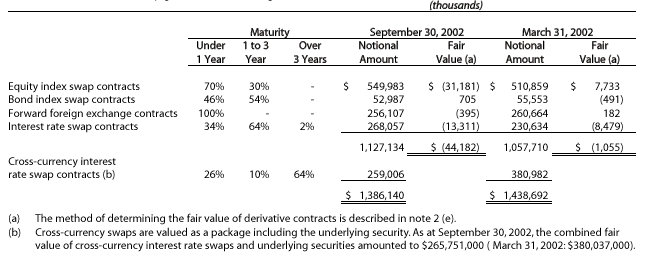
NOTE 5 INVESTMENT RISK
MANAGEMENT
Income and financial returns of the Fund are exposed to credit risk and price risk. Credit risk relates to the possibility that a loss may occur from the failure of another party to perform according to the terms of a contract. Price risk is comprised of currency risk, interest rate risk and market risk. Currency risk relates to the possibility that the investments will change in value due to future fluctuations in foreign exchange rates. Interest rate risk relates to the possibility that the investments will change in value due to future fluctuations in market interest rates. Market risk relates to the possibility that the investments will change in value due to future fluctuations in market prices.
The Standing Committee on the Alberta Heritage Savings Trust Fund reviews and approves the business plan of the Fund. In order to earned an optimal financial return at an acceptable level of risk, the 2002-2003 business plan limits investments of the Transition Portfolio to include only fixed-income securities other than securities transferred from the previous structure and proposes the following asset mix policy for the Endowment Portfolio.
Fixed income securities 25% to 45%
Equities 75% to 55%
Risk is reduced through asset class diversification, diversification within each asset class, quality and duration constraints on fixed-income instruments, and restrictions on amounts exposed to countries designated as emerging markets. Controls are in place respecting the use of derivatives (see Note 4). Forward foreign exchange contracts may be used to manage currency exposure in connection with securities purchased in foreign currency (see Note 4).
NOTE 6 FUND EQUITY
Section 8 (2) of the Alberta Heritage Savings Trust Fund Act (the Act) states that the net income of the Heritage Fund less any amount retained in the Fund to maintain its value shall be transferred to the General Revenue Fund (GRF) annually in a manner determined by the Minister of Revenue. The Fund's net loss for the six months ended September 30, 2002, amounting to $659,670,000 has been applied against retained earnings and is carried forward to reduce transfers to GRF resulting from income earned in the remaining six months of the fiscal year ending March 31, 2003. As at September 30, 2002 the Fund's total receivable from GRF, amounting to $180,000,000, represents total transfers made to GRF during the four months ended July 31, 2002 based on the original budget estimate of income for the fiscal year.
Section 11(5) of the Act states that for fiscal years subsequent to 1999 and until the accumulated debt is eliminated in accordance with the Fiscal Responsibility Act, the Minister of Revenue is not required to retain any income in the Heritage Fund to maintain its value, but may retain such amounts as the Minister of Revenue considers advisable.
NOTE 7 NET LOSS
Investment income (loss) is comprised of interest, dividends, amortization of discount and premiums, swap income (loss), security lending income and realized gains and losses from sale of investments, writedowns and provision for writedowns. The Fund's share of income earned from externally and internally managed investment pools is net of administrative expenses incurred by the pools. (see Note 8).
The investment loss for the six months ended September 30, 2002 includes a provision for writedown of public equities totaling $342,405,000 (September 30, 2001: $nil) and writedowns of public equities totaling $98,330,000 (September 30, 2001: $256,224,000).
A summary of investment income (loss) is as follows:

NOTE 8
ADMINISTRATIVE EXPENSES
Administrative expense includes investment management, cash management, safekeeping costs and other expenses charged on a cost-recovery basis directly from Alberta Revenue. The Fund's total administrative expense for the period, including amounts deducted directly from investment income of pooled funds is as follows:

NOTE 9 COMPARATIVE
FIGURES
Certain comparative figures have been reclassified to conform to September 30, 2002 presentation.
NOTE 10 APPROVAL OF
FINANCIAL STATEMENTS
These financial statements were approved by the Deputy Minister of Revenue.

|

